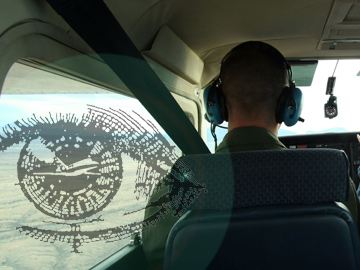
An incident at Jabiru, Northern Territory demonstrates the importance of both un-alerted and alerted see-and-avoid principles and of pilots checking the serviceability and correct operation of radio equipment before flying.
On 5 October 2012, a Beech 1900, registered VH-EMK (EMK) departed Darwin on a charter passenger flight to Jabiru. When descending into Jabiru, the crew broadcast on the Brisbane Centre frequency advising that they were 40 NM west of Jabiru, and were due to arrive at 0654. Brisbane Centre air traffic control advised that there was no traffic for the descent.
At about 0645, an Airparts FU-24 aircraft, registered VH-HVP (HVP) was being prepared for an aerial survey flight in the Jabiru area. During flight preparations the pilot turned the aircraft’s radio on and selected standby on the transponder. Shortly after, the pilot broadcast on the common traffic advisory frequency (CTAF) that he was taxiing for runway 27. At that time the pilot heard a broadcast from the crew of EMK advising that they would be established on a 5 NM final at 0654. The pilot of HVP determined that he would have 4 minutes to depart before EMK was reported to be established on its final approach.
Pilots should make use of all available resources such as an Aerodrome Frequency Response Unit (AFRU) to confirm radio serviceability.
The pilot of HVP broadcast a call advising that he was entering and backtracking runway 27 and selected ‘ALT’ on the transponder. The pilot reported that he received no reply to his broadcast and believed there was no conflict with EMK.
When about 1 NM inbound, the crew of EMK saw HVP taking off on runway 27 directly opposite their approach path. The captain immediately called for a go-around, which the first officer (FO) initiated. The FO took avoiding action by manoeuvring to the right. At the same time the pilot of HVP saw EMK on final for runway 09 and decided to continue the take-off as he did not wish to remain on the runway if the crew of EMK had not seen HVP. After take-off, the pilot of HVP turned the aircraft to the right to maintain separation from EMK.
Following the incident the crew of EMK tried to contact HVP three times, but received no reply and HVP was not observed on the TCAS (traffic collision avoidance system) display. The pilot of HVK heard a broadcast from EMK and tried to respond, but realised that his radio was only receiving and not transmitting. The two crews reported different assessments of the minimum separation of the two aircraft, but it appears that separation reduced to about 300 ft vertically and 200 to 250 m horizontally.
HVP’s communications equipment comprised a VHF radio, a HF radio and a satellite phone. A single radio selector switch was used to activate each system. The pilot of HVP reported using the satellite phone the previous day. When changing the selection back to VHF he had inadvertently placed the selector between the VHF and HF settings. He did not confirm the radio selection during pre-flight checks. The crew of EMK reported that HVP was not observed on the TCAS.
The practice of ‘see-and-avoid’ has long been the primary method for minimising the risk of collision when flying in visual meteorological conditions in uncontrolled environments and is considered a crucial element of a pilot’s situation awareness. The use of a radio, combined with a visual lookout, markedly increases effectiveness; however, pilots need to be mindful that the absence of a traffic broadcast does not necessarily mean the absence of traffic. In addition, pilots should make use of all available resources such as an Aerodrome Frequency Response Unit (AFRU) to confirm radio serviceability.
Read the report: Aircraft proximity event between Beech 1900, VH-EMK and Airparts FU-24, VH-HVP, Jabiru Airport, Northern Territory, on 5 October 2012


